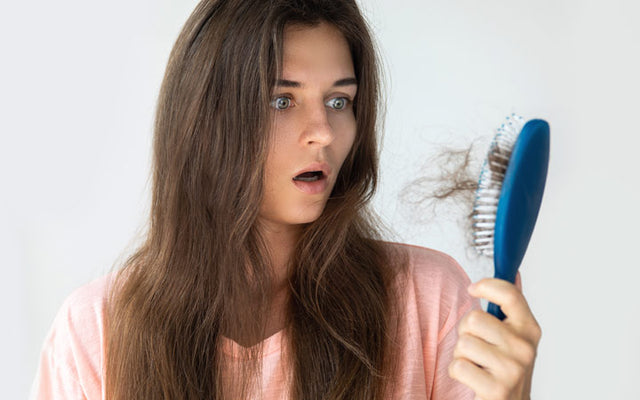When you notice a lot of hair strands on your comb or shower drain, does it set your panic mode on? Calm down, take a deep breath and relax! Some amount of hair loss every day is a normal scientific phenomenon.
You need to know how much hair fall should actually be a cause of worry, so that you can book your next appointment with the doctor at the right time. After all, no one likes false alarms. So, keep scrolling to understand this important aspect.
Highlights:
How Much Hair Fall Is Normal In A Day?
According to science and hair care experts, losing 50-100 strands [1] per day is normal. Let’s get to the details:
1. Hair Fall While Combing Or Brushing
If you notice hair fall while brushing, it may leave you perplexed. However, this is the hair that has already fallen out of the follicles. The hair brushing simply separates this hair from the rest of your hair. It is a normal phenomenon.
Do not brush your hair aggressively as it can damage the hair and make them brittle. If you have tangled hair, use a good serum or conditioner to remove the tangles.
If you notice unusual clumps of hair falling out while brushing, consult your doctor.
2. Hair Fall In Shower
Hairfall in the shower is also a common scenario. But, if you notice large chunks of hair clogging your shower, there might be an underlying medical condition. Consult your doctor for an accurate diagnosis. Shampoos may also be a cause of this kind of hair fall if they’re not suited to your hair type. Switch to gentler shampoos and conditioners that suit your hair.
3. Hair Fall While Oiling
Hair falling out while oiling is also a common sight. While massaging the oil into your scalp, the fallen hair will stick to your hands.
Hair fall during brushing, shampooing or oiling your hair should not bother you as long as the total number of strands that you lose in a day is below 100.
How To Test Your Own Rate Of Hair Loss?
1. Pull Test
Run your fingers through your clean and dry hair. Gently pull about 60 strands of hair in the upward direction. If around 6 hair strands fall out, it is considered normal hair fall. Above 6 hair strands may imply hair shedding.
2. Comb Test
Comb test is also another reliable method to test the number of hair strands falling out. To do this comb from the back of the top of your head to the front of the scalp. Perform this while lying on a bed and count the number of hair strands that fall out from combing. If the hair count is up to 10 hair strands it is considered normal.
What Causes Normal Hair Fall?
Losing around 50-100 strands of hair everyday is completely normal. To understand the cause of this, we need to get into the cycle of hair growth [2]. Your hair grows in three phases:
1. Anagen - In this phase, hair begins to grow from the roots and usually lasts for 3-7 years.
2. Catagen - The hair enters a transitional phase where the hair growth slows down. This lasts for 2-4 months.
3. Telogen - Old hair falls out and new hair strands start growing. This phase lasts for about 3 months.
Did You Know?
- Healthy adults have 80,000 to 1,20,00 hair strands on their head. On any given day 5-10% of your hair is in the telogen phase and hence you observe hair fall.
Hair Fall In Women Vs Men
Women experience higher hair shedding when compared to men. The culprits being heat styling and coloring of hair. About 40% of women lose extra hair everyday due to the way they style their hair. Women also undergo pregnancy and childbirth and thus, it is natural for them to have episodes of hair shedding.
Hair Shedding Versus Hair Loss
If you notice more than 100 strands falling out of your head everyday, you may experience hair shedding. Hair shedding is different from permanent hair loss. Hair shedding can be fixed once you've identified the triggers or causes like
- Stress [3]
- Childbirth
- Trauma
- Birth control pills
- Recovery from an illness or a surgery
After the body has adjusted from such stressful conditions, you may notice the hair fall getting under control.
Medical conditions like thyroid, hormonal changes in menopause [4] and cancer can also lead to excessive hair loss. Androgenetic alopecia [5] and nutritional deficiencies may also cause excessive hair loss.
Note:
If you notice bald spots, patches and clumps of hair falling out, seek medical help immediately. Male pattern baldness and female pattern baldness is usually permanent and cannot be reversed. But there are ways you can slow down the hair shedding.
How Much Hair Falling Out Is Too Much?
Losing about 100 hair strands a day or 700 per week is classed under normal hair fall. Bald spots, patches and clumps of hair falling out can indicate medical conditions ranging from thyroid, androgenetic alopecia to telogen effluvium [6].
Busting Myths About Female Hair Loss
1. Only Men Can Experience Permanent Hair Loss
- False
Female pattern baldness leads to permanent hair loss in women although it is not as common a phenomenon as in males.
2. Sunlight Leads To Hair Thinning
- False
While UV rays from the sun are harmful to your skin, they aren't as bad for your hair. Vitamin D [7] from the sun actually helps in hair growth.
3. Hair Thinning Is Age Related
- Not entirely true
While older women nearing menopause experience hair loss, shedding of hair can happen at any age due to a lot of factors like stress, iron deficiencies, trauma or illness.
4. Frequent Trims And Cold Water Rinse Will Grow Hair
- False
Hair cuts every 6-8 weeks to ensure that your hair is free of damage and split ends. But, it does not aid in hair growth. Coldwater showers may improve circulation on the scalp but are no direct methods to grow hair.
5. Wearing A Hat Frequently Leads To Hair Loss
- False
Your hair does not need to breathe the way you're thinking. Your hair derives its oxygen from the roots. So go out and chill by flaunting those hats.
Wrapping Up
Remember that everyone's hair is different and so is the hair fall. Simplest things like hairstyles to adverse chemical processes on the hair can make the hair fall out. If you see more than 100 strands of hair falling out on a daily basis, consult your doctor to rule out any medical conditions.
1. https://www.nhp.gov.in/disease/skin/alopecia-hair-loss
2. https://www.ncbi.nlm.nih.gov/books/NBK470321
3. https://www.ncbi.nlm.nih.gov/pmc/articles/PMC5397031/
4. https://www.nia.nih.gov/health/what-menopause
5.https://medlineplus.gov/genetics/condition/androgenetic-alopecia/
Recommended Products
Was this Article helpful?
- Least helpful
- Most helpful











